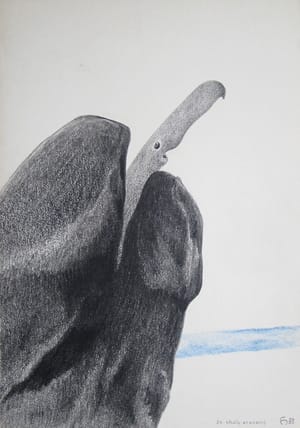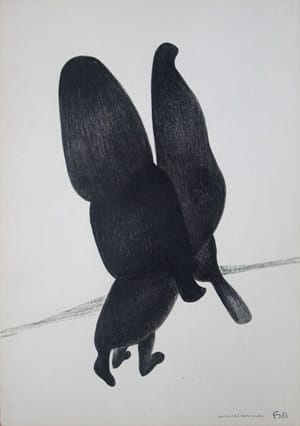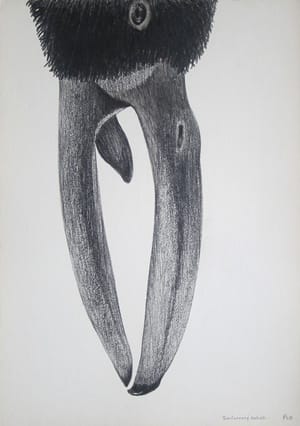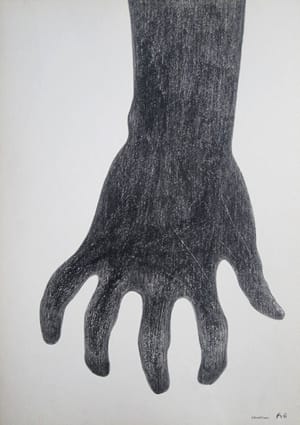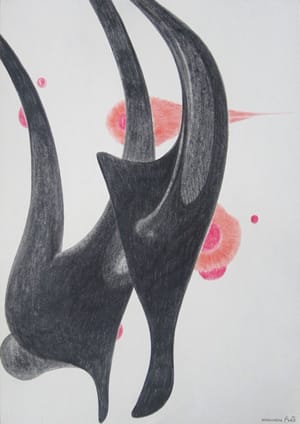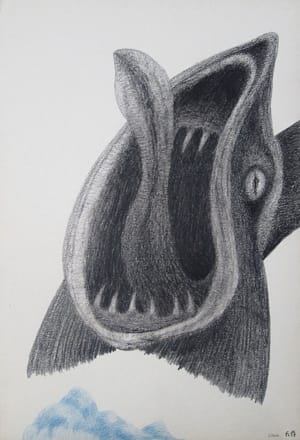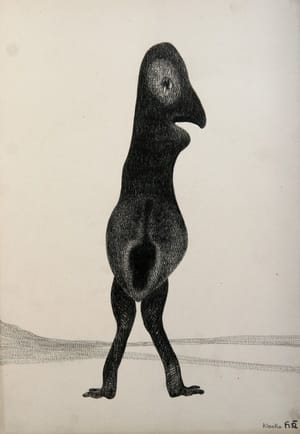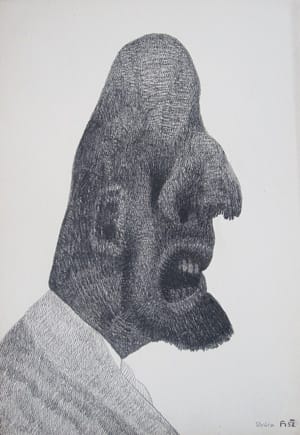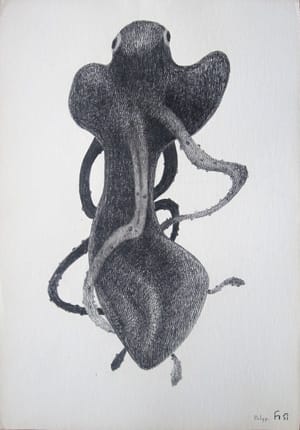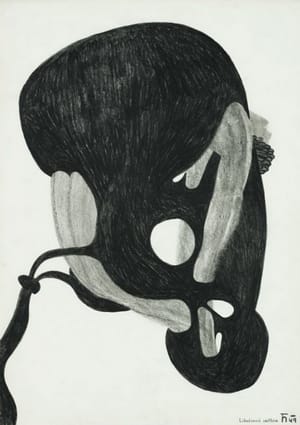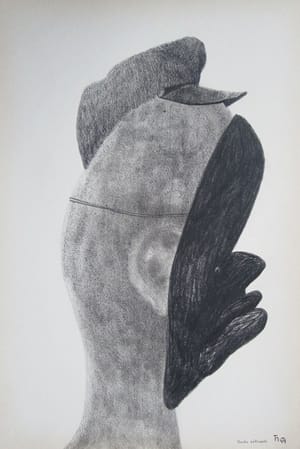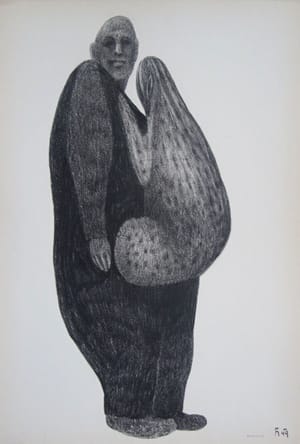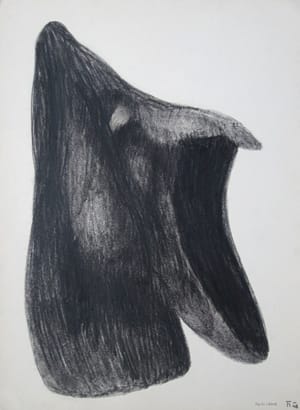- First Name
- Karel
- Surname
- Havlíček
- Born
- 1907
- Birth place
- Berlín
- Place of work
- Berlín, Praha, Děčín, Plzeň, Kadaň
- Died
- 1988
- Keywords
- CSU Library
- ↳ Find in the catalogue
About artist
Karel Havlíček is one of the most interesting figures linked with Czech art brut. This is due both to his specific style of drawing and processing his subject matter, and his life story and historical situation, which are reflected in his work. He started drawing intensively only when he was thirty-eight at the end of World War II, when he set himself the task of creating at least one drawing every day: “And that’s how I began. It was 25 November 1945 I think I’m right in saying, and since then, today and every day – or should I say night – I persist.”[1]
It was the drama of that time, the end of the war, the communist coup and the advent of Stalinism that led him to this approach. All of these events affected him both existentially and psychologically, and drawing appeared to have some therapeutic significance for him. This would account for his obsessively thorough style, in which the resulting images combine subtlety and sensitivity with the organic power of often disturbing motifs. Drawing was a tool for expressing his feelings regarding contemporary events and for distancing himself from them.
Despite being a trained lawyer and civil servant (to begin with in Děčín, and then as director of the regional police in Kadaň, from which post he was dismissed after the coup of 1948 as a non-communist and transferred to be an ordinary civil servant in Pilsen, where he was finally to give up his career as a state employee), even as a child he had been influenced by artistic circles thanks to his family and close surroundings. His father Karel Havlíček was a painter and stage designer, his cousin Josef Havlíček an architect affiliated with the Prague surrealists. Later on, when he gave up working as a civil servant and decided to devote his energies to art, an important contact was Karel Teige, who wrote an extensive analysis of Havlíček’s work and is even credited with completing a tiny sailing ship on what is undoubtedly Havlíček’s most famous drawing Gigantomachie / Outsider Art of 1948. What at first sight seems an insignificant piece of trivia shows, in fact, to what extent interpretations of his work can change, and also how a theorist of such huge importance as Teige can influence a work of art at a time dominated by surrealism in a way that is not necessarily to its benefit, when looked at with hindsight. The art historian Terezie Zemánková sums the situation up thus: “Teige was also Havlíček’s Fate, who granted him somewhat controversial gifts from today’s perspective. One of Teige’s ambiguous contributions is his artistic intervention in the drawing Gigantomachie, which Havlíček sent him to assess a year after creating it.”[2] At the same time Teige’s “intervention” in the drawing is at odds with the fact that he adjudged Havlíček’s work to be an imaginative “inner” drawing, i.e. free of the gaze of the outside world.
Karel Teige placed Havlíček’s work mainly within the context of Art Nouveau and fantasy art. In addition, he was the first to associate Havlíček at least in part with art brut – probably in order that he be accepted by the official culture of the time, i.e. socialist realism, and might exhibit his work publicly, a cause for which Teige lobbied, albeit unsuccessfully. In Havlíček he saw an artist moving between art brut and professional art and able to break down the barrier between these two artificially created worlds. However, the ideology of that time was completely at odds with Havlíček’s imaginative motifs – mostly dark and sometimes moving in the direction of abstraction – and his drawings, which were a “bizarre herbarium, illustrations from some natural history book on ghosts”, stood no chance of being accepted by official culture of that time. He was not able to exhibit publically until 1963, when he had a solo exhibition at Mánes. Teige’s study was only published in his collected works as late as 1994[3].
Havlíček’s mostly black-and-white drawings always depict one motif that most often represents a dreamlike fantasy creature from his own personal mythology. We see strange plants (Lidožravá rostlina/ Man-eating Plant, 1949), real and fantasy animals (Psí hlava / Dog Head, 1956, Praplaz / Anapsid, 1971), mythological creatures (Obr / Giant, 1952), or beings arising from the artist’s own imagination and coming together to form a unique freak show (Potvory / Monsters, 1952, Kloaka / Cloaca, 1952). In some cases the images are almost humorous and picturesque. An important role is played by the titles, which co-create the individual works and set them within an illustrative concept. Terezie Zemánková, in the catalogue to the retrospective exhibition Gigantomachie, which took place in 2012 at the Museum Montanelli, cites the characteristic traits of his drawings, which include: “[…] metamorphoses of vegetative, zoomorphic and anthropomorphic objects, a compactness and monumentalism of form situated in an empty, almost infinite space, a direct link between theme and title that often foregrounds the metaphorical significance of a drawing.”[4]
A period comparison might be ventured with František Janoušek, though parallels are also apparent in contemporary art. When we look back upon Havlíček’s work, it would appear as though he bypassed his own times and would perhaps have enjoyed greater success on the contemporary art scene. On the Czech art scene his work reminds us of the drawings of Petr Nikl or the work of the sculptress Anna Hulačová. However, as we stated above, his daily drawing was closely linked to the events of that time and with the non-literal depiction of the traumas being experienced. It is therefore difficult to imagine what his work would look like if created today and even if he would become an artist.
[1] Výtvarná práce – orgán Svazu československých výtvarných umělců, no. 26, vol. XIV., Praha, 29 December 1966. Rubrika ”Hovory”, no. 9, p. 6 (transcribed by Alexej Kusák from a tape recording).
[2] Terezie Zemánková, “Autonomní tvorba Karla Havlíčka”. Petr Hlaváček, Terezie Zemánková (eds.), Karel Havlíček: Gigantomachie. Praha 2012, p. 24.
[3] Karel Teige, The Liberation of Life and Poetry. Studies from the 1940s (a selection from vol. III), Prague 1994, pp. 387–402.
[4] Terezie Zemánková, “Autonomní tvorba Karla Havlíčka”. Petr Hlaváček, Terezie Zemánková (eds.), Karel Havlíček: Gigantomachie. Praha 2012, p. 23.
- Author of the annotation
- Alžběta Cibulková
- Published
- 2019
CV
1955–1970 dělníkem v kadaňských keramických závodech, v kamenolomu Mikulovice u Kadaně, pomocným dělníkem u Pozemních staveb a v závodě Prefa Prunéřov 1949–1955 pracuje jako designér a malíř v thunské továrně na porcelán v Klášterci Ohří u Kadaně, počátek přátelství s Jaroslavem Ježkem 1945 rozhodl se, že svůj život zasvětí umění, konkrétně kresbě 1936–1949 působil ve státní službě jako právník a policejní úředník (Děčín-Podmokly, Praha, České Budějovice, Kadaň, Plzeň) 1934 promován doktorem práv (JUDr.) na Německé univerzitě v Praze 1923 přesídlil s rodiči do Prahy, kde dokončil gymnaziální studia a absolvoval Právnickou fakultu Německé univerzity 1907 narozen v Berlíně, kde navštěvoval základní školu a reálné gymnázium
Exhibitions
- Solo exhibitions
-
2012
Karel Havlíček – Gigantomachie, Muzeum Montanelli, Praha
2007
Karel Havlíček – 100 let, Kulturní dům Střelnice, Kadaň
2006
Otevření Galerie Karla Havlíčka se stálou expozicí jeho díla, Galerie Karla Havlíčka, Kadaň
2002
Karel Havlíček – výtvarné dílo, Galerie Pod Věží, Kadaň
1998
Imaginäre Skulpturen, Wilhelm Lehmbruck Museum, Duisburg, SRN
Karel Havlíček – Výtvarné dílo, Galerie Pod Věží, Kadaň
Karel Havlíček – Dravci na zdechline alebo anatomie démona, České centrum Bratislava, Slovensko
1996
Fantaskní svět Karla Havlíčka, Galerie Paideia, Praha
1995
Výstava kreseb a porcelánu, Galerie Pod Věží, Kadaň
1993
Einblicke in eine phantastische Welt – Zeichnungen des Künstlers Karel Havlíček, Dresdener Bank, Bergisch Gladbach, SRN
Karel Havlíček – Výběr z díla, Galerie umění Karlovy Vary – Letohrádek Ostrov nad Ohří
Karel Havlíček – Výběr z díla, Ostravské muzeum, Ostrava
1992
Karel Havlíček, Galerie Gambra, Praha
1991
Religion und Mythos – Heinz Trökes, Karel Havlíček und Henry Moore, Wilhelm Lehmbruck Museum, Duisburg, SRN
1985
Ein Monat im Schaffen des „h“, Ludwig Museum, Köln, SRN
1983
Ludwig Museum, Köln, SRN
1980
Museum moderner Kunst, Vídeň, Rakousko
1978
Karel Havlíček. Handzeichnungen, Haus Bitz Frechen, Frechen, SRN
1970
Karel Havlíček – Kresby, Galerie umění Karlovy Vary
1968
Karel Havlíček, Hornický klub, Chomutov
1967
Karel Havlíček – Fantaskní kresby, Dům Pánů z Kunštátu, Brno
Karel Havlíček – Obrazy, Galerie bratří Čapků, Praha
Kresby Karla Havlíčka, Galerie umění Karlovy Vary – Letohrádek Ostrov nad Ohří
1965
Karel Havlíček, Kulturní dům, Klášterec nad Ohří
Výstava keramiky Karla Havlíčka, Kulturní dům, Kadaň
1964
Ptáci a ryby, Poetický klub Viola, Praha
Karel Havlíček – Kresby, Dům důchodců, Kadaň
Fantaskní kresby, Divadlo Vítězslava Nezvala, Karlovy Vary
Fantaskní kresby Karla Havlíčka, Lékařská fakulta UJEP, Brno
Fantaskní kresby – Karel Havlíček, Kulturní dům, Kadaň
1963
Kresby, Výstavní síň Mánes, Praha
- Group exhibitions not included in ARTLIST.
-
2010
Vary(i)ace – Kresba II, Galerie umění Karlovy Vary – Letohrádek Ostrov nad Ohří
Roky ve dnech. České umění 1945-1957, Městská knihovna v Praze
2009
Hypnos. Images et inconscients en Europe (1900 – 1949), Musée de l´Hospice Comtesse, Lille, Francie
2008
Art brut v českých zemích, Galerie výtvarného umění, Cheb; Muzeum umění Olomouc
Art brut – collection abcd, The Museum of Modern Art, Shiga, Japonsko
2006
art brut, sbírka abcd, Dům U Kamenného zvonu, Galerie hlavního města Prahy, Praha
2005
Syrové umění – Sbírka Jana a Evy Švankmajerových, Pražákův palác, Brno
2004
Syrové umění – Sbírka Jana a Evy Švankmajerových, Galerie U Bílého jednorožce, Klatovy
Abcd, une collection d´art brut, Pavillon des arts, Paříž, Francie
2003
Tsjechische l´art brut tchèque, Musée d´art spontané, Brusel, Belgie
2002
L´art brut tchèque, Halle Saint Pierre, Paříž, Francie
2000
Tschechischer Surrealismus und Art Brut zum Ende des Jahrtausends, Palais Palffy, Vídeň, Rakousko
1998
l´art brut – umění v původním (surovém) stavu, Dům U Kamenného zvonu, Galerie hlavního města Prahy, Praha
- Collections
- Muzeum umění Olomouc Soukromé sbírky sbírka autorovy rodiny
Monography
- Monography
Vratislav Effenberger: Homogenita, objekt a humor v díle Karla Havlíčka, Kresby Karla Havlíčka, Galerie umění Karlovy Vary, 1967. Karel Neumann: Fantaskní kresby Karla Havlíčka, Galerie bratří Čapků, 1967. Karel Teige: Kresby Karla Havlíčka, Galerie umění Karlovy Vary, 1967. Karel Havlíček – Kresby, Galerie umění Karlovy Vary, 1970. Gotthard Schwinge: Karel Havlíček. Handzeichnungen (úvodní stať katalogu k výstavě), Frechen, Haus Bitz, 1978. Gotthard Schwinge: Einblicke in eine phantastische Welt, SIMPL – Verlag, Köln, 1979. Gotthard Schwinge: Horror Arvicolae, Kölner Universitätsverlag, Köln, 1984. Christoph Brockhaus: Karel Havlíček. Pandamonium gezeichneter Plastiken 1958-1985, Duisburg, Wilhelm Lehmbruck Museum, 1987. Vratislav Effenberger: Karel Havlíček, in: Karel Havlíček výběr z díla, Galerie umění Karlovy Vary, 1993. Ivo Pondělíček: Umění z hlubinných zdrojů, in: Karel Havlíček výběr z díla, Galerie umění Karlovy Vary, 1993. Karel Teige: Kresby Karla Havlíčka, Osvobozování života a poezie, Výbor z díla III., Praha, Aurora, 1994. Gotthard Schwinge, Karel Havlíček. Imaginare Skulpturen, Duisburg, Wilhelm Lehmbruck Museum, 1998. Juraj Mojžíš: Dravci na zdechline alebo anatómia démona, Bratislava, České centrum, 1998. Jarmila Havlíčková: Karel Havlíček – život a dílo, Město Kadaň, Kadaň, 2002. František Dryje et al., Syrové umění – Sbírka Jana a Evy Švankmajerových, Praha 2004. Zdeňka Čepeláková: Vary(i)ace – Kresba II, Galerie umění Karlovy Vary 2010. Marie Klimešová: Roky ve dnech. České umění 1945-1957, Praha 2010. Petr Hlaváček, Terezie Zemánková (eds.): Karel Havlíček – Gigantomachie. Praha 2012.
- Articles
Jana Hofmeistrová, Klášterecký porcelán, Tvar I/IV, 1951. Ivo Pondělíček, Karel Havlíček, Kulturní tvorba II, 1964. Vesmír, č. 6, 1964 – reprodukce na obálce. Ladislav Kočica, Neskončené zápasy malířské tvorby, Průboj XVI., č. 145, 1964. Zdeněk Petrovič, Fantaskní kresby Karla Havlíčka, Nástup V., č. 43, 1964. Ivo Mička, Malíř posedlý básní, Nástup VI., č. 3, 1965. Pavel Fiala, Noční malíř, Průboj XVII., č. 51, 1965. Anna Linhartová, Démoni Karla Havlíčka, Lázeňský časopis, Karlovy Vary, XII/1965. Alexej Kusák, Rozhovor s Karlem Havlíčkem, Výtvarná práce XV., č. 9, 1967. Karel Miler, Kresby Karla Havlíčka, Výtvarná práce XV., č. 9, 1967. Jana Hofmeistrová, Dvě pražské výstav, Havlíček a Tikal, Práce XXIII., č. 107, 1967. Jana Hofmeistrová, Z pražských výstavních síní, Mladá fronta XXIII.,č. 97, 1967. Jana Hofmeistrová, Bizarní malířův svět, večerní Praha XXIII, č. 79, 1967. Libuše Brožková, Z našich výstavních síní, Lidová demokracie XXIII, č.89, 1967. Ertie Kim, Komische Visionen und Traumgestalten, Volkszeitung XVI., č. 12, 1967. Jan Šmíd, 80 a 80, Výstavy v Galerii bratří Čapků Praze, Rudé právo 31. 3. 1967. Luboš Hlaváček, Kresby z hlubin představivosti, Mladá fronta XXIII., č. 322, 1967 Anna Linhardtová, Démoni Karla Havlíčka, Lázeňský časopis Karlovy Vary, č. 12, 1967. Zdenka Čepeláková, Klíč ke třinácté komnatě, Stráž míru XXII., č. 48, Karlovy Vary, 1967 . Vladimír Vítek, Karel Havlíček a jeho životní dialog, Dialog, č. 11, Ústí nad Labem, 1968. Vladimír Vítek, Kadaňský kreslíř Karel Havlíček, Nástup IX., č. 25, 1968. Oldřich Beran, Kresby Karla Havlíčka, Pravda VII., 9. 1. 1968. J. Pacovský, Sveřepý outsider, Mladý svět XI., č. 3, 1969. Analogon 1, 1969 (reprodukce). Zdenka Čepeláková, Dvacetiletá tvorba Karla Havlíčka, Pravda, č. 64, 1970. Vratislav Effenberger, Karel Havlíček, Bulletin de Liaison surréaliste, č. 5, Paris, 1972. Frechen (sch.)., Suche nach der Wahrheit hinter der Logik, Kölner Land, 24. 1. 1978. Frechen (sk.)., Zum erstenmal im Westen gezeigt. Ausstellung tschechischer Künstler in Haus Bitz eröffnet, Kölner Stadt-Anzeiger, 25. 1. 1978. Suzanne Kreitz, Dämonen, Ängste und Gespenster, Blätter von Karel Havlíček, Rheinischer Merkur, Frechen, 3. 2. 1978. Frechen (zen), ČSSR, Künstler stellt erstmals im Westen aus, Frechener Stadtnachrichten, 25.1. 1978. Peter Jovischoff, Havlíček´s groteske Welt, Die Welt, 17. 7. 1979. Peter Klucken, Graphiken im Stadttheater: Religion und Mythos, Westdeutsche Allgemeine Zeitung, Rheinische Post, 20. 4. 1991. Analogon č. 8, 1992 (reprodukce). Karlovarské noviny, roč. 3 , 138, 1993 „han“: Sonda (tužkou) do lidské duše. Karlovarské noviny r. 3/97, 1993: Fantaskní kresby Karla Havlíčka (zč). Zdenka Čepeláková: Karel Havlíček, Ateliér 8/1993. Ivo Pondělíček, Vratislav Effenberger, Karel Havlíček, Labyrint-Revue č. 1/1994. Ivo Pondělíček, Erotická tvorba je diferencovaná, Labyrint-Revue č. 9-10/ 1994. Ateliér 6/1994 představujeme: Galerie Gambra (snímek k výstavě Karla Havlíčka). Jan Gabriel, Surrealistická kresba jako otevřené téma, Ateliér 8/1997. Petr Hlaváček, Karel Havlíček a Karel Teige aneb umění v „surrealistických časech“, Umění 4/2006. Petr Hlaváček, Karel Havlíček aneb umění v „surrealistických časech“ I-VI, Kadaňské noviny 2006.
- Other critical texts
Ivo Pondělíček: Fantaskní umění, Praha, NČSVU, 1964. Vratislav Effenberger: Výtvarné projevy surrealismu, Praha, Odeon, 1969. Zdenka Čepeláková, Božena Vachudová: Karel Havlíček, Výtvarní umělci Karlovarska, Karlovy Vary, Galerie umění Karlovy Vary, 1989. Analogon 8/IV, 1992 (reprodukce). Alena Nádvorníková: Karel Havlíček a surrealismus, Český surrealismus 1929-1953, Praha, Argo, Galerie hlavního města Prahy, 1996. Ladislav Daněk: Mezi tradicí a experimentem 1939-1989, Olomouc, Muzeum umění Olomouc, 1997. Eva Neumannová, Alena Nádvorníková: Surrealistická obraznost a kresba, NG Praha, 1997. Alena Nádvorníková: Karel Havlíček, Revolver Revue 36, 1997. Alena Nádvorníková: l´art brut – umění v původním (surovém) stavu, Praha, Galerie hlavního města Prahy, 1998. Alena Nádvorníková: Karel Havlíček a surrealismus, K surrealismu, Praha, Torst, 1998 Vlastimil Tetiva: Podoby fantaskna v českém výtvarném umění, Hluboká nad Vltavou, Alšova jihočeská galerie, 1998. Christoph Brockhaus (Hg.): Zeichnungen, Duisburg, Wilhelm Lehmbruck Museum, 1998. Alena Nádvorníková: Tschechischer Surrealismus und Art Brut zum Ende des Jahrtausends, České centrum Vídeň, 2000. Alena Nádvorníková: L´art brut tchèque, Paříž, Halle Saint Pierre, 2002. Vladimír Valeš: Kadaňsko výtvarné 1900-2000, Středisko knihovnických a kulturních služeb, Chomutov, 2002. Alena Nádvorníková: Tsjechische l´art brut tchèque, Brusel, Musée d´art spontané, 2003. František Dryje, Bruno Solařík, Martin Souček: Syrové umění – Sbírka Jana a Evy Švankmajerových, Arbor vitae, Galerie Klatovy / Klenová a Moravská galerie v Brně, 2004. Bruno Decharme, Vincent Gille: Abcd, une collection d´art brut, Paříž, Paris - Musées, 2004. Barbara Šafářová, Terezie Zemánková: art brut, sbírka abcd, Praha, abcd, 2006. Ivo Pondělíček: Outsiderova zpověď. Vzpomínky a sebereflexe, Praha, Pragma, 2007. Alena Nádvorníková: Art brut v českých zemích, Arbor vitae, Muzeum umění Olomouc, 2008. Yamamoto Atsuo, Asai Yuki, Bruno Decharme, Barbara Safarova: Art brut – collection abcd, Shiga, The Museum of Modern Art, 2008. Petr Hlaváček: Svědkové minulosti, Osobnosti Kadaňska 19. a 20. století, Město Kadaň, 2008. Savine Faupin, Christophe Boulanger, Nicolas Surlapierre: Hypnos. Images et inconscients en Europe (1900 – 1949), Musées d´Art moderne Lille Métropole, 2009. Petr Hlaváček: Obrazy z kadaňských dějin, Město Kadaň, 2011.
